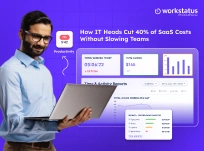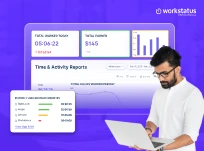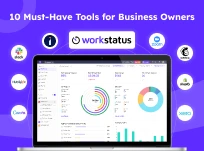Table of Contents
In today’s business world, employee monitoring and data confidentiality are crucial considerations for any organization. With the rise of digital communication and the increasing reliance on technology in the workplace, companies need systems to ensure that their employees are using company resources appropriately and that sensitive information is protected. One such way is using employee monitoring. The primary function of employee monitoring is to track employee productivity.
Many businesses now use employee monitoring software to track employee productivity, monitor email usage, and restrict access to certain apps, or websites. This helps them ensure that their people are securely using computers and that confidential data is kept from unauthorized individuals.
Organizations related to different niches and industries are using employee monitoring to protect themselves from the potential risks of data leakage and other external threats.
According to the report, the use of employee monitoring mediums is most prevalent in advertising and marketing (83%), computer technology (77%), business and finance (60%), manufacturing (60%), and personal care services (52%) to ensure better security of data and operations from external threats.

While employee monitoring and data confidentiality are important considerations for any business, finding the right tools and methods to achieve security are critical.
In this blog, we will be discussing what employee monitoring is, how it is related to data confidentiality, what are the dangers of data breaches, and how monitoring can help prevent that.
For businesses with stricter compliance needs, opting for on-premise deployment can offer greater control over sensitive data while still enabling effective employee monitoring.
Not only this, but we will also discuss why a company should invest in ensuring data confidentiality, best tools and techniques for employers to monitor employees.
So whether you are a business owner, HR professional, or employee, this blog will provide valuable insights and guidance on these important topics to help you maintain the confidentiality and security of your data.
Now without any further ado, let’s dive in and start with our first topic.
A Brief History Of Employee Monitoring
The history of employee monitoring can be traced back to the early 20th century when companies first began to keep track of the time and productivity of their employees. This was typically done through the use of time clocks or punch cards, which allowed managers to track the hours worked by each employee.
In the 1980s and 1990s, the rise of computers and the internet led to the development of more advanced employee monitoring systems. These systems often use software to track employee activity on company computers, including the websites visited and the amount of time spent on specific tasks.
As technology has continued to evolve, employee monitoring has become increasingly sophisticated. Today, companies use various tools and techniques to monitor their employees, including time tracking, task monitoring, activity & location tracking, video surveillance, and much more.
These technologies have made employee monitoring even more comprehensive, making it easier for employers to ensure that their workforce works securely and productively to achieve their organizational goals.
Now that we know the history of employee monitoring let’s examine what it actually is.
What Is Employee Monitoring?
Let’s define employee monitoring, it refers to the practice of tracking and monitoring employees’ activities while working. This can be done for various reasons, such as ensuring that employees are following company policies, improving productivity, protecting sensitive information, or ensuring employees’ safety.
There are many different employee monitoring methods, including software to track internet usage and computer activity, surveillance cameras, and GPS tracking devices.
No matter what medium of employee monitoring you choose, it aims to ensure that employees are following company policies and guidelines, maintaining productivity, and not engaging in activities that could harm the company’s reputation or bottom line.
As now we have a better understanding of what employee monitoring is, let’s now talk about why it is making its way back to businesses. Why it is on the boom and what are its different types
Why Is Employee Monitoring Coming Back?
There’s no doubt that employee monitoring software is making a comeback.
In fact, a recent study by the American Management Association found that nearly 60% of organizations are now using some form of monitoring method to track employee activity.
What is the reason for the increased monitoring of employees at work by organizations?
There are a number of reasons why this trend is on the rise, but some of the major reasons why employee monitoring software is making a comeback are
1) Improved Productivity: Employee monitoring allows managers to track the productivity of their employees and identify any areas where they may be struggling or falling behind. This can help managers provide additional support and resources to ensure that all employees are meeting their targets and contributing to the company’s overall success.
2) Accountability: By having visibility into employee activities, managers can ensure that their staff is accountable for any errors or omissions made in the process. For example, if an employee fails to complete a task on time, management can pinpoint the responsible person and address the issue accordingly. This level of accountability can help employees stay motivated and engaged in their work.
3) Increased Security: Employee monitoring helps prevent data leaks and other security breaches by tracking employee access to sensitive information and alerting managers to suspicious activity. This can help protect the company’s sensitive data and intellectual property and reduce the risk of costly legal action.
4) Improved Compliance: Employee monitoring can help ensure that employees are following the company’s policies and regulations, as well as any applicable local, state, or federal laws. This helps better protect the company from costly fines and legal action for non-compliance
5) Greater Transparency: By monitoring employees’ activities and operations in real-time, management can have complete visibility among their staff and be better able to identify any potential issues or discrepancies. This can help managers quickly address problems and ensure all employees work collaboratively in a cohesive manner.
These are some of the reasons why employee monitoring is coming back and gaining more popularity, as it helps employers to stay informed about their employees, as well as to increase efficiency in the workplace.
The Rise of Employee Monitoring: Insights showing the reasons Why Companies Are Jumping Onboard for adopting employee monitoring
- To ensure data safety and security, 78% of companies use employee monitoring software to track worker performance and online activity.
- 78% of employers use employee monitoring software to monitor employee performance and/or online activity. 90% actively track employees’ time on work and non-work related activities to ensure total transparency.
- 60% of companies with remote employees use employee monitoring mediums to track employee activity and monitor employee productivity. Another 17% are considering it.
- 53% of employees whose activity is monitored spend 3 hours or more on non-work activities each day
- Workers’ productivity increased in 81% of companies that implemented monitoring software.
Types Of Employee Monitoring Systems
![]()
- Time Tracking: These software solutions allow employers to record an employee’s time working on a particular task or in general.
- Productivity Tracking Systems: These systems track employee productivity levels by monitoring the number of tasks completed, the amount of time spent on each task.
- Computer & Internet Monitoring Systems: These systems track employees’ internet usage, including websites, visited, the app used, and the amount of time spent on certain sites. They may also monitor employee computer usage, including the programs and applications used.
- Communication Monitoring: This system tracks employees’ communication with coworkers and customers, including emails, phone calls, and instant messages. It can also record in-person conversations if the company has a recording system.
- GPS Tracking: This system tracks an employee’s location using GPS technology, which can be useful for companies with a mobile workforce or field sales teams.
Let’s now understand
How Is Employee Monitoring Linked With Data Confidentiality?
In the business world, data confidentiality is of utmost importance. Organizations want to protect their information from being accessed by unauthorized individuals, whether internally or externally. This is where employee monitoring comes in.
Employee monitoring can be linked to data confidentiality practices in many ways, some of which are shared below.
1- Employee monitoring ensures that sensitive or confidential information is not being accessed or disclosed without authorization. Employee activity monitoring on company systems detect any inappropriate access or sharing of confidential data and immediately alerts the management of any suspicious activity.
2- Employee monitoring is used to enforce company policies related to data confidentiality. For example, an organization may have a policy prohibiting employees from sharing login credentials or accessing certain types of sensitive information. Employee monitoring can help ensure that these policies are followed by tracking employees’ actions and notifying management when a policy violation is detected.
3- In some cases, employee monitoring may be used to detect and prevent data breaches. Monitoring employee activity help identify the unusual behavior or activities of employees that could indicate a data breach and alert the employer about potential security risks, helping them to take action to prevent a major data breach.
Employee monitoring can be an important part of maintaining data confidentiality within an organization, as it helps to ensure that sensitive information is being accessed and handled properly.
As we now know the linking of employee monitoring with data confidentiality, let’s understand
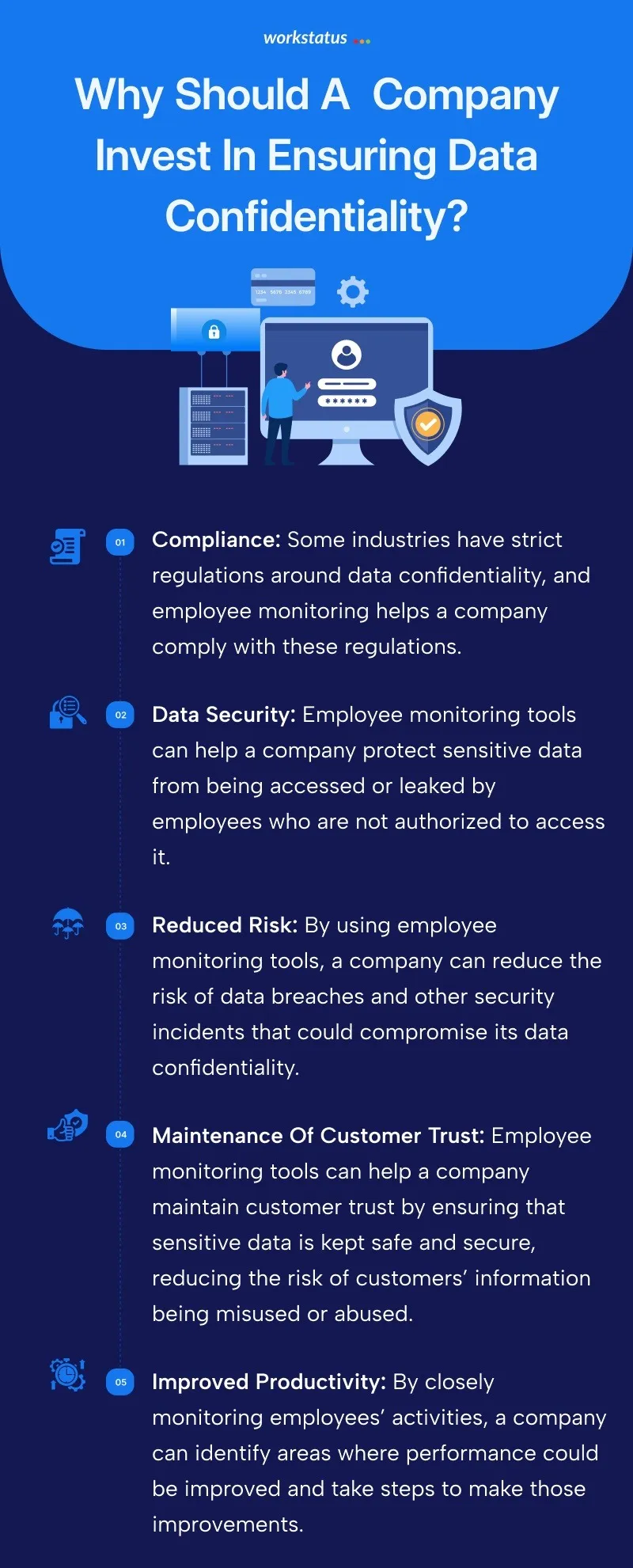
As we are familiar with the fact that companies are investing in such mediums, let’s now talk about
Data Breaches: What Are The Dangers, And How Does Employee Monitoring Deal With Them?
Data breaches are a reality of the modern business world and can have serious repercussions. Here, we will look at the risks employers face regarding data breaches while employees visit unauthorized websites and how employing employee monitoring software can help protect your company from these dangers.
Danger 1- Compromised Data: When employers don’t ensure that their employees are only accessing authorized websites, they can leave themselves vulnerable to potential data breaches. Not only can sensitive employee information become exposed if the website is hacked, but the customer or financial data could also be at risk.
Solution- By using employee monitoring tools, employers can ensure that their employees only access trusted websites. Such practices allow employers to set restrictions and limits on the types of websites their employees can visit, ensuring all company data remains safe and secure.
Danger 2- Unauthorized Software: Unsafe downloading or file-sharing sites pose a threat to companies because of the increased likelihood of malware being downloaded. Malware can come in many forms, allowing hackers to gain access to sensitive data without an employee noticing. Employee monitoring software can act as an effective deterrent against this type of activity.
Solution: By monitoring downloads, employers can protect their business by ensuring that only trusted software is used. Allowing employees to download certain applications through a password-protected portal will also help secure data, as only authorized users can access the approved programs.
Danger 3- Phishing: Phishing attacks are one of the most common threats to company data. Through phishing emails, attackers can gain access to employee and customer information.
Solution: By using employee monitoring software, employers can ensure that their team does not click on malicious links or download suspicious files from these emails. Employee monitoring tools can monitor network activity and alert employers whenever suspicious phishing attempts occur. Employers can then take action quickly to protect any sensitive information that may have been jeopardized.Additionally, incorporating phishing simulators into employee training programs can help identify vulnerable employees and provide targeted education to prevent future attacks.
Knowing the problem and solution provided by employee monitoring helped us to understand why having employee monitoring strategies is crucial. Now let’s look at some of its benefits
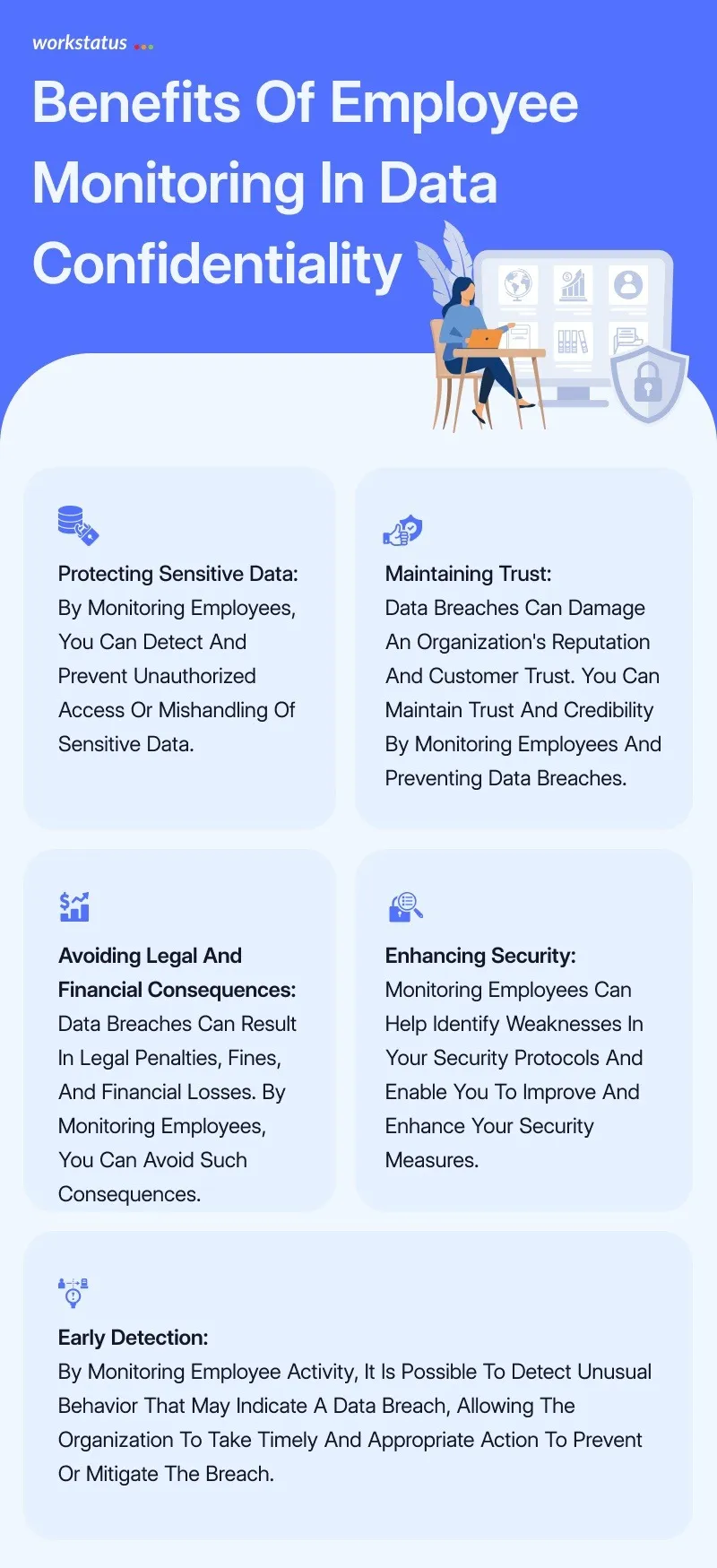
Knowing just the benefits is not enough, let’s now understand some of its
Pitfalls Of Not Monitoring Employees
There are several potential pitfalls of not monitoring employees in data confidentiality.
One is that confidential information may be unintentionally leaked. This can happen if an employee accidentally sends an email containing confidential information to the wrong person or if they leave their laptop open and unattended in a public place.
Another potential pitfall is that malicious insiders may deliberately leak confidential information to harm the company or gain some personal advantage. This type of leak is often much harder to detect and prevent than an accidental one, as the insider may take steps to cover their tracks.
Even if no actual data is leaked, not monitoring employees can give the appearance that the company does not take data security seriously, which can damage its reputation. Finally, not monitoring employees can also lead to losing competitive advantage.
If a company’s confidential data is leaked or stolen, it can lead to the loss of competitive advantage. This can be especially detrimental if the data includes trade secrets, customer information, or other sensitive information.
Not only can this hurt a company from a financial standpoint, but it also creates distrust among customers and partners, which could lead to loss of business in the future.
Due to these pitfalls, it becomes highly crucial that companies take appropriate measures to monitor their employees.
As we now have a great knowledge of how employee monitoring is a major part of maintaining data confidentiality, let’s now cover some of the hot topics of employee monitoring
The Controversy Clouding Employee Monitoring: Privacy Vs. Security
The controversy surrounding employee monitoring centers on balance between privacy and security.
On the one hand, employers argue that monitoring employee activity can help ensure the security of sensitive information, prevent fraud and misconduct, and increase productivity. On the other hand, employees may feel that monitoring invades their privacy and violates their rights.
One of the main arguments for employee monitoring is that it can help protect against cyber threats and data breaches. With the increasing reliance on technology in the workplace, employers may need to monitor employee activity to ensure that sensitive information is not being accessed or shared without permission.
However, some employees may feel this type of monitoring goes too far and infringes upon their privacy. They may feel that their employer is monitoring their every move and that their privacy is being violated. This can lead to resentment and a lack of trust in the workplace.
Ultimately, the debate over employee monitoring comes down to finding a balance between the employer’s needs and the employees’ rights. Employers should be transparent about their monitoring practices and ensure they only monitor employees for legitimate business purposes.
Employees should also be aware of the company’s policies and what is expected of them in terms of their online behavior.
Employee Monitoring Tools: A Threat To Privacy Or Productivity Booster?
Employee monitoring tools can be seen as both a threat to privacy and a security necessity, depending on how they are used and implemented.
On the one hand, employee monitoring tools can track and monitor employees’ online activities and communications, infringing on their privacy and making them feel like they are constantly being monitored. This can lead to a decrease in employee morale and productivity and a potential increase in employee turnover.
On the other hand, employee monitoring tools can also be used as a security necessary to protect sensitive company information and data. For example, if an employee is accessing and sharing sensitive information without proper authorization, employee monitoring tools can help identify and prevent this type of activity.
Ultimately, companies need to strike a balance between using employee monitoring tools as a security necessity and respecting their employees’ privacy.
This can be achieved through clear and transparent communication about using these tools and implementing policies and procedures to ensure that employee privacy is protected.
Legalities That Organizations Should Take Care Of While Monitoring Employees
Organizations have a legal responsibility to take care while monitoring employees.
This is especially true when it comes to the use of various mediums for monitoring. If an organization does not take care while monitoring employees, they could face serious legal consequences.
Here are some of the legal considerations an organization should take when monitoring employees:
- Privacy laws: Organizations must ensure they are not violating privacy laws while monitoring employees. This may include obtaining consent from employees before monitoring their emails, phone calls, or internet usage.
- Discrimination laws: Employers must be careful not to discriminate against employees based on their age, race, gender, religion, or any other protected characteristic while monitoring their activities.
- Data protection laws: Employers must protect any personal data collected during employee monitoring by data protection laws, such as the General Data Protection Regulation (GDPR) in the European Union.
- Employment laws: Employers must be mindful of employment laws when implementing employee monitoring policies and practices. This includes ensuring that employees are treated fairly and not subjected to unfair or unreasonable surveillance.
- Labor laws: Organizations must adhere to labor laws when monitoring employees, including ensuring that employees are given breaks and are not overworked.
- Health and safety laws: Employers must ensure that employee monitoring practices do not compromise the health and safety of employees. This may include ensuring that employees are not subjected to excessive surveillance or monitoring that could cause stress or anxiety.
- Union rights: If an organization has unionized employees, it must consider collective bargaining agreements and ensure that employee monitoring practices align with them.
With these considerations in mind, organizations can ensure that they are properly monitoring their employees while also staying within the bounds of the law.
Employee Monitoring: An Employee’s Right To Privacy
Employee monitoring is a common practice in many workplaces. Employers often use time-tracking software, surveillance cameras, and internet monitoring software to track employee productivity and behavior.
While this practice can be useful for improving efficiency and identifying potential issues, it also raises concerns about an employee’s right to privacy.
According to employment laws, employees have a reasonable expectation of privacy in the workplace. This means that employers must respect an employee’s privacy and can only monitor their behavior or activity if it is necessary for the business. Employers must also inform employees about monitoring practices and ensure that the monitoring is not excessive or intrusive.
There are also specific laws that regulate employee monitoring, such as the Electronic Communications Privacy Act (ECPA) in the United States, which prohibits employers from intercepting or monitoring employee emails or other electronic communications without their consent.
Despite these legal protections, employees may still feel uncomfortable or concerned about being monitored at work. It is important for employers to be transparent about their monitoring practices and to ensure that they are not invading their employees’ privacy.
This can help build trust and create a positive work environment for all employees, leading to increased productivity and better performance.
Congratulations, now you are completely equipped with the knowledge of employee monitoring. However, knowing the best tool to monitor employees will surely take your grip to the next level.
Best Tools And Techniques For Employers To Monitor Employees
There are several tools and techniques that employers can use to monitor employees, including:
1) Employee Monitoring Software
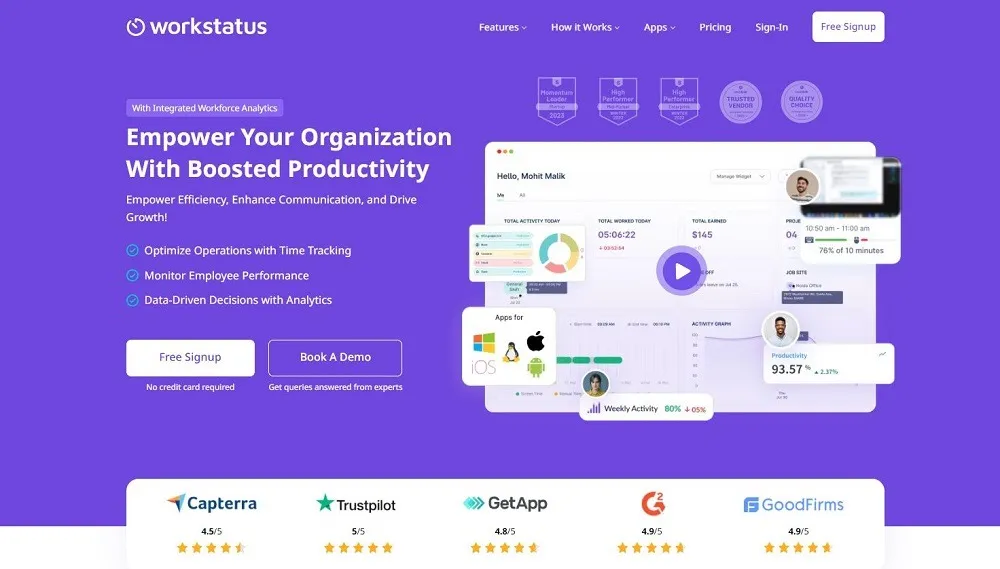
It can be a valuable tool for employers to protect the confidentiality of their data. They can track employee activity, including email and internet use, file transfers, etc. This can help employers to identify potential threats and take action to protect their data.
Moreover, these software also ensures the confidentiality of the data such as employee information, company data, financial records, client information, and much more.
By using employee monitoring software, employers can identify potential security risks within their organizations and take preventive measures to protect the company’s sensitive information from unwanted access by unauthorized personnel.
2) Data Leakage Prevention
Data leakage prevention software is a type of security software that helps to protect sensitive data from being leaked out of an organization. It does this by monitoring and controlling the flow of information in and out of the network and encrypting data so unauthorized people cannot read it.
3) Access Controls
Employers can implement access controls to restrict employee access to certain data or systems based on their job duties and responsibilities. This can include setting up user accounts and passwords and limiting access to specific devices or locations.
These tools are effective tools for employers to detect and prevent data breaches. You can opt for any medium as per your needs.
However, we suggest you opt for employee monitoring software. There are ample options out there that can protect your data and provide insight into employees’ productivity and performance, allowing you to make data-driven decisions for the betterment of businesses.
Coming to the last topic, let’s understand
How Employee Monitoring Software Work?
- Install Software: The first step in using employee monitoring for data confidentiality is to install the monitoring software on all company devices and devices used by employees for work purposes. This can include computers, laptops, tablets, and smartphones.
- Set Up Monitoring Parameters: Once the software is installed, the employer or administrator can set up the parameters for which data should be monitored and how often. This includes emails, internet browsing, file access, and keystrokes.
- Monitor Activity: The employee monitor software will then continuously monitor the activity of the employees on their devices. This includes collecting data on the websites they visit, the files they access, and the emails they send and receive.
- Generate Reports: The software will then generate reports on the activity of the employees, including any potentially confidential information that has been accessed or shared. The employer or administrator can access these reports to maintain data confidentiality.
- Alert For Potential Breaches: If the employee monitor software detects any potential breaches of data confidentiality, it will alert the employer or administrator. This allows for prompt action to be taken to address the issue and prevent further breaches.
- Encrypt Data: Some employee monitoring software also includes data encryption capabilities to further protect confidential information. This can help to prevent unauthorized access to sensitive data even if an employee’s device is lost or stolen.
- Regular Updates: It is important to update the employee monitor software to ensure it runs smoothly and effectively. This can include updating the monitoring parameters and installing any necessary patches or security updates.
Conclusion
After considering all the evidence, it is clear that employee monitoring is necessary to ensure data confidentiality within an organization. While it may be seen as an invasion of privacy, the risks of data breaches and leaks are too high to ignore.
By monitoring employee activity organizations can identify and prevent potential threats to data confidentiality.
Additionally, employee training and education on data security practices can further enhance data confidentiality within the organization. Employees need to understand the importance of protecting sensitive information and the consequences of not doing so.
Overall, employee monitoring is necessary to ensure data confidentiality and protect the organization’s interests. It is important for organizations to strike a balance between privacy and security, and strive to create a secure and productive workplace environment.
That’s all for today.
We hope this blog has been informative and helpful.
Thanks for reading!



